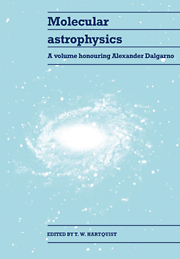Book contents
- Frontmatter
- Contents
- Dedication
- Preface
- Part I Molecular clouds and the distribution of molecules in the Milky Way and other galaxies
- 1 Molecular clouds in the Milky Way
- 2 Molecules in galaxies
- Part II Diffuse molecular clouds
- Part III Quiescent dense clouds
- Part IV Studies of molecular processes
- Part V Atomic species in dense clouds
- Part VI H2 in regions of massive star formation
- Part VII Molecules near stars and in stellar ejecta
- Part VIII Moderately ionized gas and chemistry at large redshifts
- Index
1 - Molecular clouds in the Milky Way
Published online by Cambridge University Press: 10 December 2009
- Frontmatter
- Contents
- Dedication
- Preface
- Part I Molecular clouds and the distribution of molecules in the Milky Way and other galaxies
- 1 Molecular clouds in the Milky Way
- 2 Molecules in galaxies
- Part II Diffuse molecular clouds
- Part III Quiescent dense clouds
- Part IV Studies of molecular processes
- Part V Atomic species in dense clouds
- Part VI H2 in regions of massive star formation
- Part VII Molecules near stars and in stellar ejecta
- Part VIII Moderately ionized gas and chemistry at large redshifts
- Index
Summary
The cloudy structure of our Galaxy
The interstellar medium (ISM) in our Galaxy is in a complex state. The temperature and the density vary by about five and ten orders of magnitude respectively. The medium is exposed to cosmic rays and starlight and contains magnetic fields. Its average density is about 10−24 g cm−3, or about one hydrogen atom per cubic centimeter, corresponding to 0.025 M⊙ pc−3. Thus on average one solar mass of the medium is contained in 40 pc3. About 75% of the medium is hydrogen, about 25% is helium, and the remaining part (about 2%) is in heavier atoms. A large fraction of the heavier elements has condensed out as dust grains having an average density of about 0.001 M⊙ pc−3.
The local kinetic gas temperatures range from 10 K to 106 K. These temperatures correspond to energies which are much lower than those typical of cosmic rays. The lower temperatures correspond to energies which are less than those typical for starlight. Cosmic rays and starlight drive processes including ionization; hence, the ionization structure sometimes is very far from that in a gas in thermal equilibrium at the gas kinetic temperature. The energy density of cosmic rays is ≈0.5 eV cm−3, of Galactic magnetic fields ≈0.2 eV cm−3 (≈10−6G), and of diffuse starlight ≈0.5 eV cm−3. Hence there is a rough equipartition of energy among these components. The description of the interaction of matter with radiation is complicated by the huge variation of opacities for different wavelengths.
- Type
- Chapter
- Information
- Molecular AstrophysicsA Volume Honouring Alexander Dalgarno, pp. 3 - 34Publisher: Cambridge University PressPrint publication year: 1990
- 10
- Cited by

